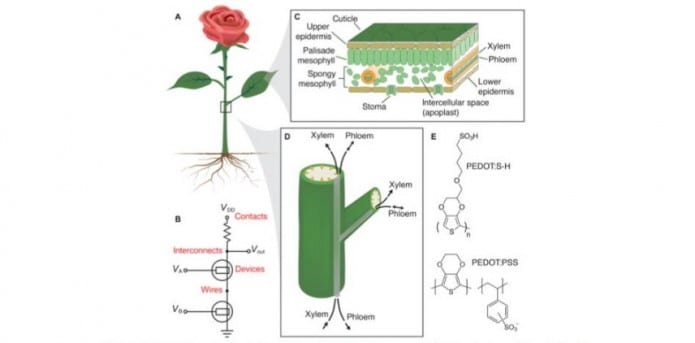Scientists create electronic circuit inside a living rose plant
Swedish scientists from the Linköping University for the first time have created a working electronic circuit inside a rose using the plant’s vascular system.
The groundbreaking research was led by Professor Magnus Berggren, Linköping University’s Strategic Research Centre for Organic Bioelectronics director and Organic Electronics professor. The team at Laboratory of Organic Electronics (LOE) is hopeful that the cutting-edge research would give birth to organic electronics and new tools.
The team with the help of synthetic polymers managed to use the vascular system of rose stems to build the basic parts of electronic circuits inside the plant. According to the paper, the researchers claim, “The four key components of a circuit have been achieved using the xylem, leaves, veins, and signals of the plant as the template and integral part of the circuit elements and functions.”
Berggren and his team experimented more than a dozen different polymer electronic building blocks to figure out the one that could conduct an electrical current inside the plant. They dissolved them in water, then placed roses—either with intact roots or cut at the stem—in the water to see whether the organics would be wicked upward. All of the building blocks either clogged the base of the stem or didn’t assemble into wires.
After many failed attempts, the team finally managed to find a synthetic polymer that could assemble itself into conducting wires up to 10 cm long inside the plant’s xylem channel while still allowing the transport of water and nutrients to keep the plant alive.
The combination led to the creation of an electrochemical transistor that converts ionic signals into electronic output. The research team then sucked out the air from the rose’s leaf and filled it with the same polymer using the vacuum infiltration process. This lead to the creation electrochemical cells pixels segregated by the veins. When voltage was applied, the polymers interacted with the leaf’s ions causing it to change color.
Until now, the team has only got as far as using these conductive wires to light up ions in the leaves of the plants, but the implications of the technology can go further. Berggren said in a phone call that he was “basically breathless” to see how well the conducting wires had worked for the first time.
“Now we can really start talking about power plants—we can place sensors in plants and use the energy formed in the chlorophyll [to power them], produce green antennae, or produce new materials,” he said of the potential applications. “Everything occurs naturally, and we use the plants’ own very advanced systems.”
“Right now we are trying to put electrodes into the leaves with enzymes that we connect to the electrodes,” he said. “The sugar that is produced in the leaves is converted by the enzyme; they deliver a charge to the electrode and then hopefully we can collect that charge in a biofuel cell.”
“The future will include using many different types of energy conversion systems,” he said about potential further developments. “What percentage of that will be from plants I can’t say but plant energy for sure opens up a completely novel way to harvest from the world around us.”
“When we have tapped out resources from nature in the past we have always chopped it or burnt it,” he added. “Maybe this could be a way of tapping energy from plants without having to kill them.”
